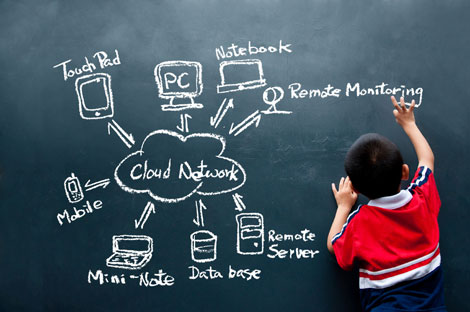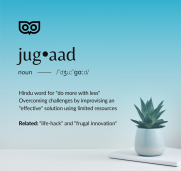Sunshine on a rainy day: eleven essential questions about cloud computing
This guest blog post was written by Francesca Geens from IT Consultancy Digital Dragonfly.
When I mention cloud computing to some people they say they don’t know what I am talking about– well they are in good company – recent research has shown that nearly half of those not using cloud computing don’t know what it means.
In this blog post I’ll address those common questions which people ask me about cloud computing:

1. Is there a difference between ‘The Cloud’ and ‘Cloud Computing’? Isn’t it just the same as the internet?
Yes ‘The Cloud’ is a common metaphor for the internet but the term ‘cloud computing’ refers to on-demand services supplied over the internet.

2. So what exactly is cloud computing?
The term refers to using and storing data which is not physically kept on your computer but which you access and save online. In addition to pure storage very often a service is also provided. Think of it as doing things over the internet that you would normally only ever have done on your computer such as word processing, storing files, photo editing, project management, etc.

3. What do you mean by ‘services’?
You can think of it as a utility like electricity or gas — where you are the end user, and don’t need to worry about where it comes from or how it gets to you; you only pay for what you use.
Popular micro-business services include:
- Cloud storage and back-up such as that offered by Dropbox, SugarSync and Crashplan
- CRM, for example by Highrise and Salesforce
- Accounting/Invoicing packages from SageOne, Freshbooks or Crunch
- Productivity, project management and document sharing such as that offered by Basecamp, Backpack and Huddle
- Mailing list management by MailChimp, ConstantContact or Mad Mimi.

4. I’ve heard of Software as a Service (SaaS). Is that cloud computing then?
Yes, absolutely, that is exactly what it is! Contact Management Software is a perfect example of software you would traditionally have used just on your computer. Now with services like Highrise you access the software and your data entirely in the cloud. SaaS lets you access the latest technology without the steep price tag. Instead of investing in expensive hardware or software you can pay for the best of both on demand.

5. Why does everyone keep talking about it? Is it new?
Cloud computing isn’t really all that new (the term was first used in scholarly circles in 1997) but the range of services available to individual and business users is growing rapidly. With cloud computing now seen as a viable alternative to managing your own hardware and software (with the costs and space implications of in-house servers and IT departments) many businesses are actively transferring their whole operation to the cloud. Even for the one-person business new offerings like Office365 (which is about to be launched by Microsoft) will make cloud working affordable and easily accessible to every size business.

6. But where does my data actually go?
Huge and highly secure data-centres filled with servers. To give you an idea of the scale both in terms of size and investment, look no further than Microsoft’s data centre in Chicago. One of the largest built to date, it spans 65,000 square meters, cost $500 million and has the potential to hold 300,000 servers.

7. Isn’t it a slower way of working?
In most cases it won’t affect your day-to-day experience but obviously you are totally dependent on having internet access. If you are going to transfer large amounts of data to the cloud for storage do expect this to take some time (it took me several weeks to upload my family photo archive).

8. And what if I don’t have internet access? I won’t be able to work!
Yes this is an important consideration, but some browser-based applications will cache a copy of your work in progress on your computer so you can work offline and then sync up to the cloud when you are done.

9. Sounds great, but is it safe?
Can we trust those that hold our data, documents and photos? What if my data gets hacked into? Well, you probably do your banking online so in many ways that decision has-been made for you. You can also take comfort in the amount of due diligence which your bank and other global organisations who have chosen to utilise the cloud must have gone through before deciding to make the change.
Data is encrypted during transfer to and from the data centres at the same level of encryption used when you enter your credit card details during online banking. The reputational risk to the main providers of rack space like Amazon, Google and Microsoft is so high that these have well-documented and regularly audited security technologies in place.
I have written elsewhere about password best-practice, which for most people will by far be their weakest link when it comes to the security of their data.

10. So what are the advantages of cloud computing?
- It’s cheaper or free: I won’t go into the detail of why it is cheaper for businesses with servers to transfer to the cloud in this post but many great services and storage options for individual users or micro-businesses are free.
- You always have the latest version of the software and upgrades are constant and seamless: no need to physically purchase a program and then buy and install upgrades.
- Pay as you go: you can spread the cost and ease your cash flow by paying for what you use on a monthly basis.
- Its good for the planet: data centres are a much more efficient way of sharing resources, and statistics show that environmental impact of a business converting to the cloud reduces their IT carbon footprint by 90%.

11. But what can it really do for me?
Well for me the silver lining to cloud computing is that it helps me to be more productive- I can access what I want where I want it and don’t need to worry about where something is saved or whether it is backed up. From a business point of view I don’t need to physically be in the same place as my documents, emails, address book to keep working. Most services also have a phone app meaning you can access your data and keep working on the go.
Hopefully by now you’ll be sold on the idea of cloud computing and will be wondering how can you best make the most of the cloud in your home and business life- free up time, be more productive and save money. You might have noticed that there is a vast range of cloud-based apps and services out there. I have mentioned just a fraction of the really great ones in this post, and if you are feeling like you don’t know where to start and don’t know how to choose which might be right for your business then look out for future blog posts in which I’ll take a closer look at my favourite cloud-based services.
About Francesca
Francesca Geens runs an IT consultancy called Digital Dragonfly, which just works with one-person businesses. She is especially interested in productivity and the use of information technology to improve people’s day-to-day business lives. Find out more about how Digital Dragonfly can help you at www.digitaldragonfly.co.uk.



Comments
Tamsin Fox-Davies
Great run-down Francesca.
I love cloud-based applications, although I don’t always want to be connected to the internet in order to use them.
However, tools like Dropbox work online AND offline, and I’m sure that’s only going to become more common (at least I hope so!).
tx
Karen Haller
Great article. I use many cloud computing storage apps. No worries about back-ups, storage etc… all taken care of!
Joe Hewes
Impressive statistic there about the reduction in carbon footprint, something to think about for green commerce. Thanks for the heads-up Francesca.
Francesca
Thanks for your comments Tamsin and Karen- I think there will be some great developments in cloud apps in the coming months and years- cloud storage options seem to be developing weekly in their pricing and options- exciting times!
Anthony Fox-Davies
As much as I appreciate CDNs and cloud computing power and opportunities I have to say that recent Amazon downtime has shocked me so much that I would *never* in the future rely on any one cloud service. Be it hosting, SAAS or anything else.
It’s long established that backups are vital and it use to be normal for missiona critical content to be mirrored. Nowadays I would expect said content to be mirrored across clouds because, as we have learned from Amazon – no one thing is too big to FAIL.